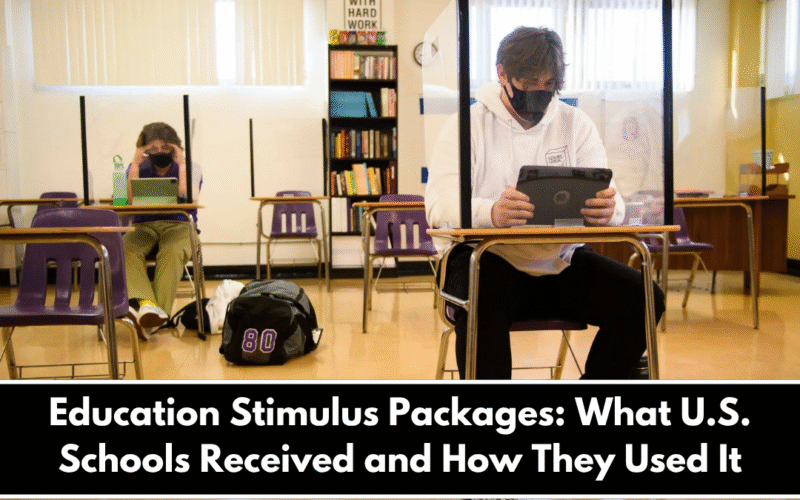During the COVID-19 pandemic, U.S. schools faced major disruptions. To support them, the federal government passed three big stimulus packages that provided nearly $190 billion to K-12 schools. These funds were aimed at reopening schools safely, helping students catch up academically, and addressing gaps in resources and learning. This article explains how much money schools received and how it was spent. It also explores whether the money helped students recover from pandemic-related setbacks.
What Schools Received — ESSER Funding Timeline and Amounts
The federal government passed three stimulus laws between 2020 and 2021 to help schools:
- CARES Act (March 2020) – About $13.2 billion in education funds.
- CRRSA Act (December 2020) – Added $54.3 billion in education funds.
- American Rescue Plan (March 2021) – The largest, with $122 billion going to K–12 education.
Combined, these laws provided around $189.5 billion in Elementary and Secondary School Emergency Relief (ESSER) funds.
The money was sent to state governments, which then passed it on to local school districts. The amount each district received depended on the number of students and how many came from low-income families.
Each of the three packages had spending deadlines. CARES funds had to be used by September 2022, CRRSA by September 2023, and American Rescue Plan (ARP) funds by September 2024.
How the Funds Were Used – Key Focus Areas and Challenges
Main Areas of Spending
- Learning Recovery Programs
At least 20% of the funds from the American Rescue Plan were required to be spent on programs that helped students catch up academically. These included tutoring, summer school, longer school days, and mental health support. - Hiring and Staffing
Many districts used the money to hire additional teachers, substitute staff, counselors, and tutors. This helped reduce class sizes and support students who needed extra attention. - Health and Safety Improvements
Schools invested in better ventilation systems, air purifiers, hand sanitizer stations, and cleaning supplies to keep students and staff safe during in-person classes. - Technology and Online Learning Tools
A significant amount of funding went into buying laptops, tablets, internet hotspots, and software for virtual learning. This helped students, especially in rural or low-income areas, attend school online when needed.
Challenges and Criticism
Although the funding helped many schools, not all of it was used wisely:
- Some districts were slow in spending the money, causing delays in program implementation.
- A few cases were reported where districts spent the money on things like renting stadiums or luxury hotels that had little to do with student learning.
- Some schools depended on the funds to pay for new tutoring and mental health programs, but these were later canceled when federal rules changed, leaving gaps in support.
- Even with billions spent, national test results showed only small improvements. Students recovered about one-third of lost math learning and one-quarter in reading.
The education stimulus packages were a historic effort to help American schools recover from the pandemic. The nearly $190 billion given to schools allowed them to hire staff, upgrade facilities, and support student learning and well-being. While many schools used the funds effectively, others struggled with planning and oversight. Some funds were misused, and learning gains were smaller than hoped. Still, the stimulus offered valuable lessons on how to invest in education during a crisis. As the last round of funding expires in September 2024, schools must focus on using the remaining money wisely. Long-term success will depend on how well the lessons from this stimulus period are applied in the future.
FAQ’s:
1. How much money did U.S. schools receive in stimulus funding?
U.S. public schools received around $189.5 billion through the CARES Act, CRRSA Act, and American Rescue Plan.
2. What were schools required to spend the money on?
At least 20% of the funds from the American Rescue Plan had to be used for helping students recover from learning loss. Schools also used funds for safety, staffing, and technology.
3. What types of programs were funded?
The money funded tutoring, summer school, extra teachers, ventilation upgrades, cleaning supplies, laptops, internet hotspots, and more.
4. Were there any problems with how the money was used?
Yes. Some districts spent money on items not directly related to student needs. Others didn’t spend the funds fast enough or had to cancel programs when rules changed.
5. Did the stimulus funds help students catch up?
Some progress was made, especially in math and reading. But overall, students only regained part of the learning they lost during the pandemic, and more support is still needed.
